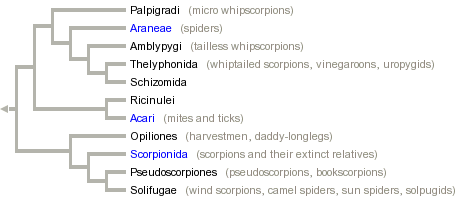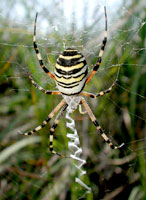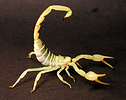Arachnida
Spiders, mites, scorpions, whipscorpions, pseudoscorpions



This tree diagram shows the relationships between several groups of organisms.
The root of the current tree connects the organisms featured in this tree to their containing group and the rest of the Tree of Life. The basal branching point in the tree represents the ancestor of the other groups in the tree. This ancestor diversified over time into several descendent subgroups, which are represented as internal nodes and terminal taxa to the right.

You can click on the root to travel down the Tree of Life all the way to the root of all Life, and you can click on the names of descendent subgroups to travel up the Tree of Life all the way to individual species.
For more information on ToL tree formatting, please see Interpreting the Tree or Classification. To learn more about phylogenetic trees, please visit our Phylogenetic Biology pages.
close boxReferences
Braddy, S. J., R. J. Aldridge, S. E. Gabbott, and J. N. Theron. 1999. Lamellate book-gills in a late Ordovician eurypterid from the Soom Shale, South Africa: support for a eurypterid-scorpion clade. Lethaia 32:72-74.
Coddington, J. A. and R. K. Colwell. 2001. Arachnids. Pages 199-218 in Encyclopedia of Biodiversity. Volume 1. S. A. Levin, ed. Academic Press, San Diego, California.
Dunlop, J. A. and M. Webster. 1999. Fossil evidence, terrestrialization and arachnid phylogeny. Journal of Arachnology 27:86-93.
Giribet, G., G. D. Edgecombe, W. C. Wheeler, C. Babbitt. 2002. Phylogeny and systematic position of Opiliones: a combined analysis of chelicerate relationships using morphological and molecular data. Cladistics 18:5-70.
Shultz, J. W. 1989. Morphology of locomotor appendages in Arachnida - evolutionary trends and phylogenetic implications. Zoological Journal of the Linnean Society 97:1-56.
Shultz, J. W. 1990. Evolutionary morphology and phylogeny of Arachnida. Cladistics 6:1-38.
Shultz, J. W. 1994. The limits of stratigraphic evidence in assessing phylogenetic hypotheses of recent arachnids. Journal of Arachnology 22:169-172.
Starobogatov, Y. I. 1990. System and phylogeny of Arachnida (analysis of morphology of paleozoic groups) [Russian]. Paleontologicheskii Zhurnal 24:4-17.
Weygoldt, P. 1998. Evolution and systematics of the Chelicerata. Experimental & Applied Acarology 22:63-79.
Weygoldt, P. and H. F. Paulus. 1979. Untersuchungen zur Morphologie, Taxonomie und Phylogenie der Chelicerata. 1. Morphologische Untersuchungen.. Zeitschrift für Zoologische Systematik und Evolutionsforschung 17:85-116.
Weygoldt, P. and H. F. Paulus. 1979. Untersuchungen zur Morphologie, Taxonomie und Phylogenie der Chelicerata. 2. Cladogramme und die Entfaltung der Chelicerata. Zeitschrift für Zoologische Systematik und Evolutionsforschung 17:177-200.
Wheeler, W. C. and C. Y. Hayashi. 1998. The phylogeny of the extant chelicerate orders. Cladistics 14:173-192.
Information on the Internet
- The Arachnology Home Page.
- American Arachnological Society.
- British Arachnological Society.
- Introduction to the Cheliceramorpha. UCMP Berkeley.
- Arachnodata. The Arachnological Information and Coordination Agency.
- Arachnida Catalog. Department of Entomology, Texas A&M University.
- Mesozoic Arachnids: predator–prey diversity in terrestrial ecosystems. David Penney & Paul A. Selden.
- Arachnid Origins and Evolution. Jason Dunlop's home page. Museum für Naturkunde Berlin.
- Spiders on the Web. Peter Bryant's photos of spiders and other arachnids.
- The World of Spiders and Scorpions. Images from Thais in 2000.
Title Illustrations
- Pacific coast tick, Dermacentor occidentalis (Acari). Olympia, Thurston County (Washington, US).
Photograph courtesy CalPhotos, copyright © 2002 - California gold scorpion, Smeringurus mesaensis (Scorpionida). Palm Desert (California, US).
Photograph courtesy CalPhotos, copyright © 2002 - Spider, Argiope bruennichi (Araneae). Coastal grassland, Viareggio (Italy)
Photograph courtesy CalPhotos, copyright © 2002
About This Page
Page copyright © 1995 David R. Maddison
Citing this page:
Maddison, David R. 1995. Arachnida. Spiders, mites, scorpions, whipscorpions, pseudoscorpions. Version 01 January 1995 (temporary). http://tolweb.org/Arachnida/2536/1995.01.01 in The Tree of Life Web Project, http://tolweb.org/











